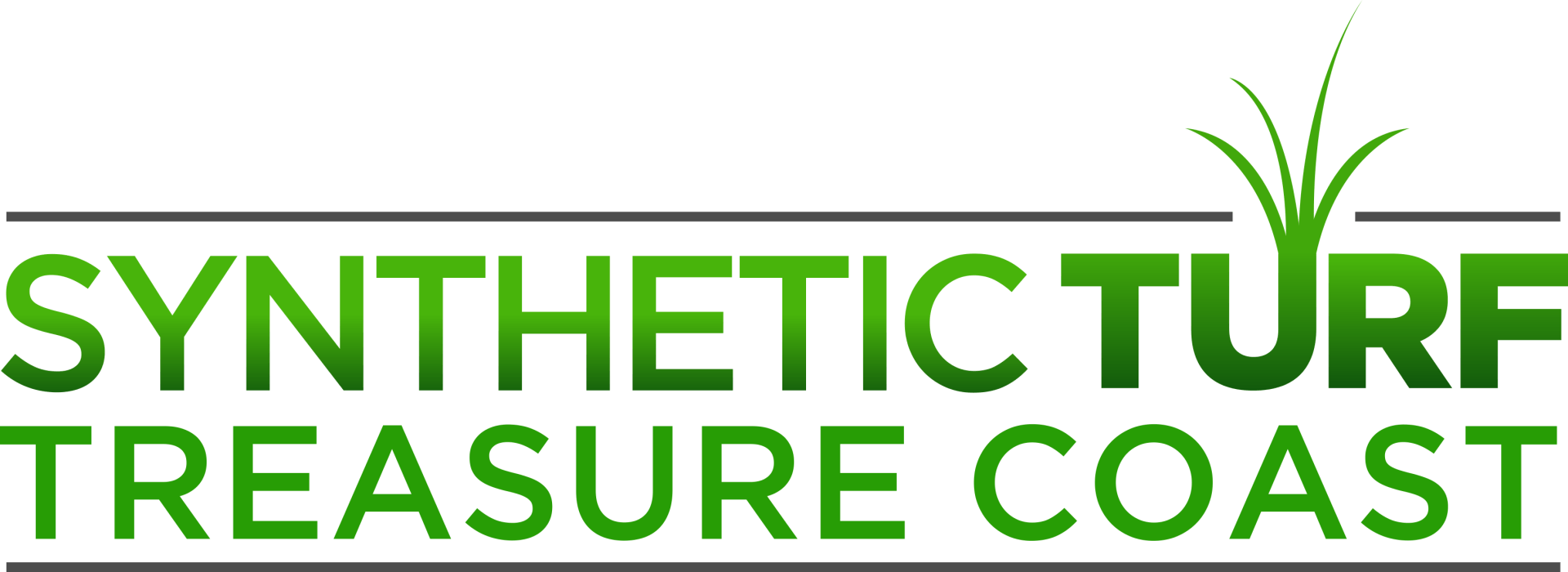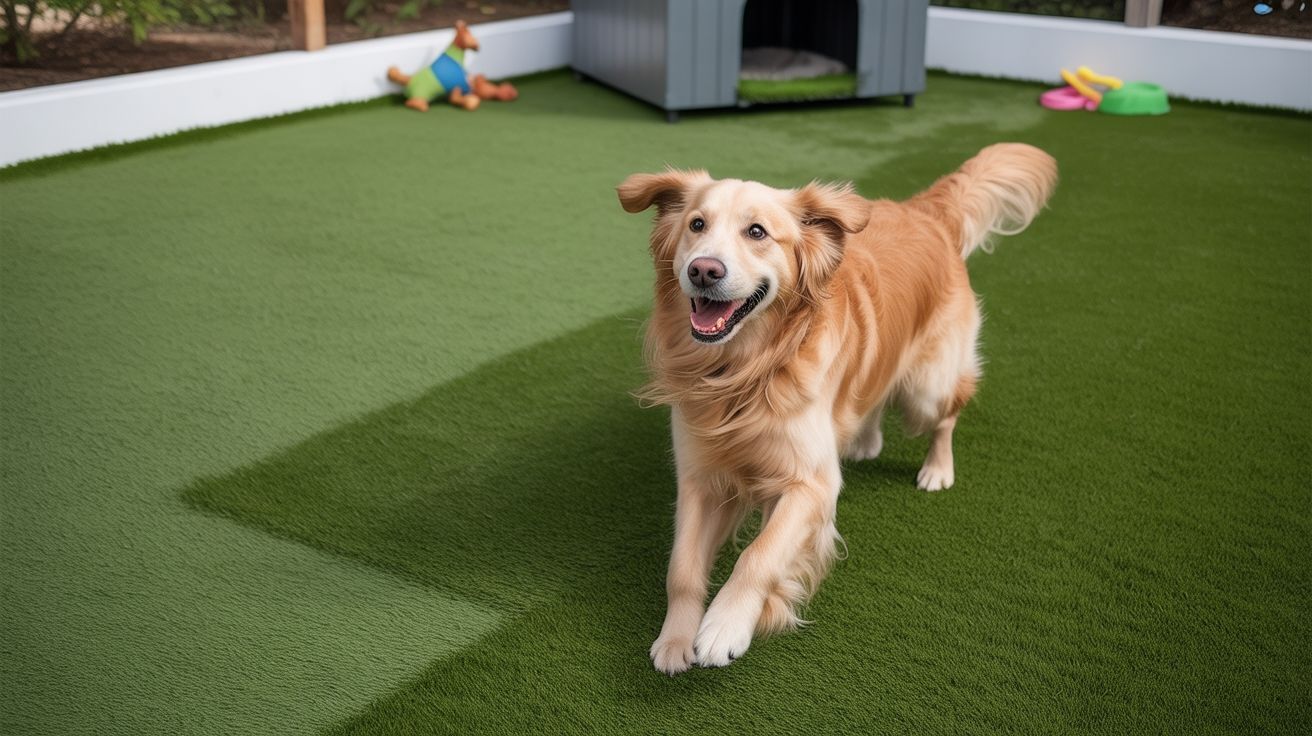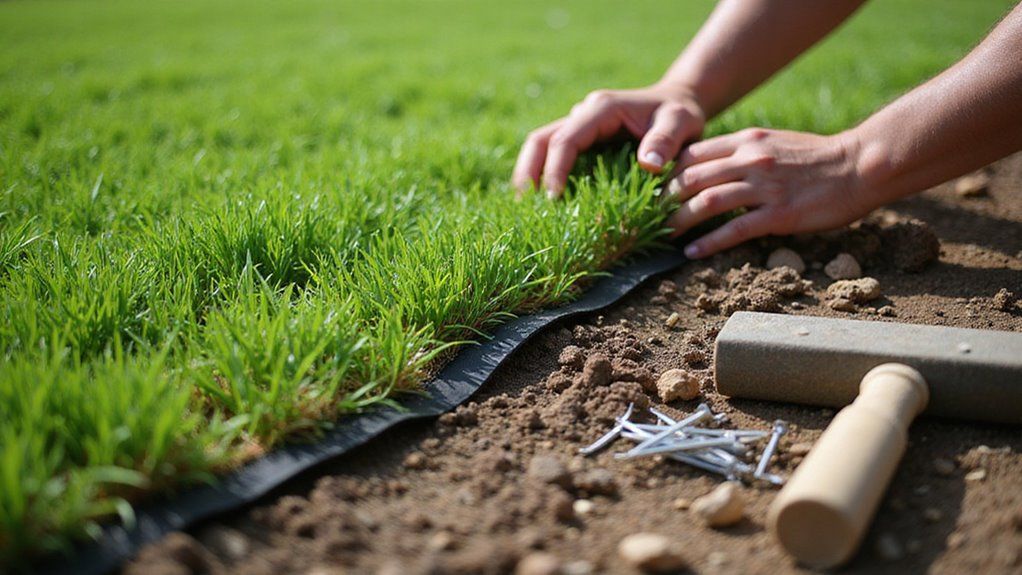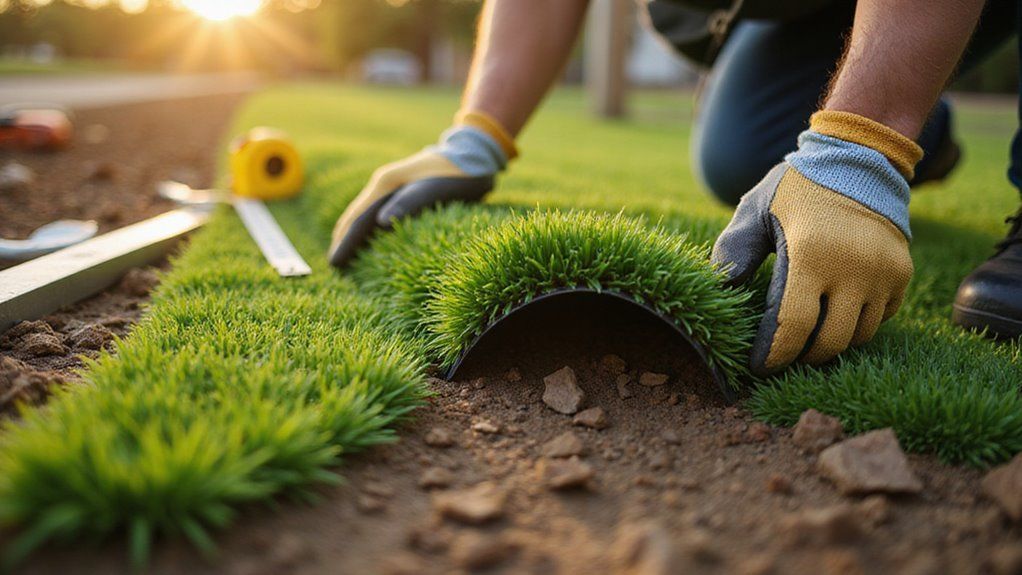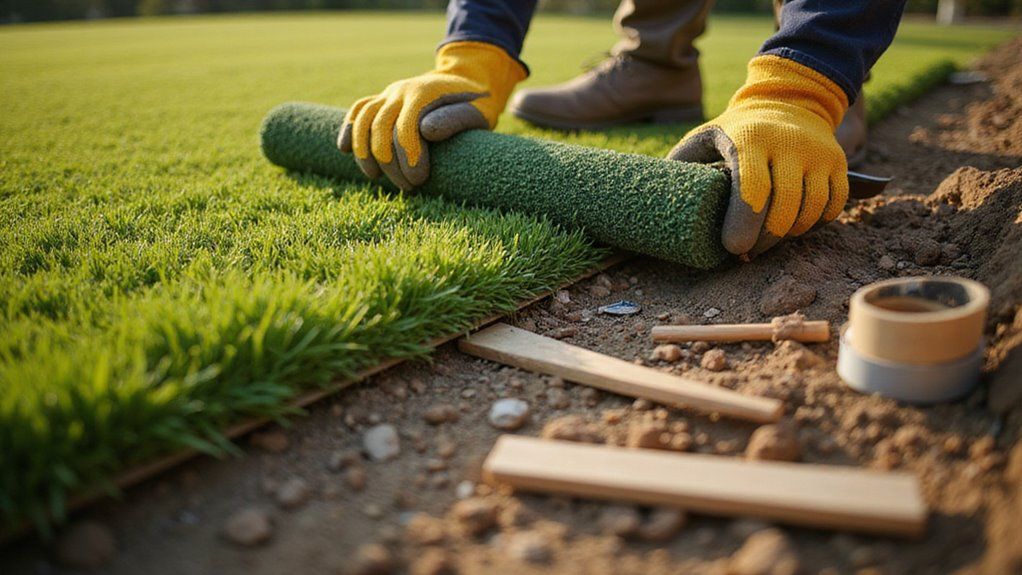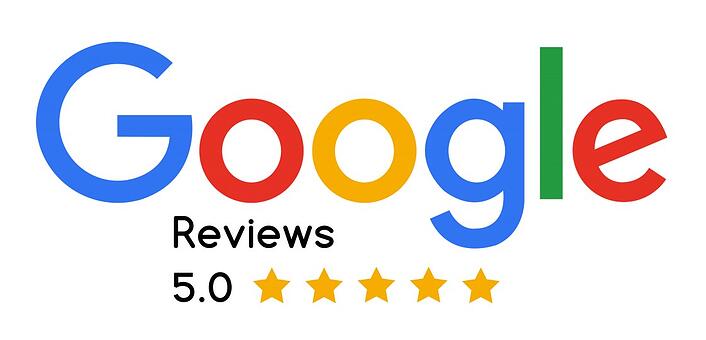Is It Cheaper to Lay Turf or Artificial Grass?

Many homeowners want a beautiful lawn but feel stuck choosing between natural turf and artificial grass. Each option has its own price tag and work involved. Knowing which is truly cheaper can be confusing.
The wrong choice could mean spending more money or time than planned. Ongoing care, surprise costs, and long-term value often get overlooked. This uncertainty can make the decision stressful and frustrating.
There’s a simple way to clear up the confusion. Artificial grass is usually cheaper in the long run, even though turf costs less upfront.
Comparing both the starting price and future expenses helps you make the best choice for your budget. This blog will guide you step by step so you can pick the most cost-effective lawn for your needs.
Key Takeaways
- Natural turf is significantly cheaper to purchase and install upfront, costing around £3–£7 per m² versus £10–£30 per m² for artificial grass.
- Artificial grass has higher initial installation costs due to specialized materials and labor requirements.
- Natural turf incurs ongoing expenses for watering, mowing, fertilizing, and pest control, increasing long-term costs.
- Artificial grass requires minimal maintenance after installation, resulting in lower ongoing costs over its 15–20 year lifespan.
- Over many years, artificial grass can become more cost-effective due to substantial savings on maintenance and water bills.
Comparing Upfront Costs
Upfront costs for turf and artificial grass are quite different. Natural turf usually costs less to buy and install. Artificial grass is more expensive at the start.
Natural turf prices are often between £3 and £7 per square meter. If you choose artificial grass, expect to pay £10 to £30 per square meter. Turf also needs less specialized labor, which keeps installation costs lower.
If you work with an experienced turf installation professional, you may also benefit from insights on design and material longevity that help plan your long-term investment.
If you have a tight budget, natural turf saves money at first. Artificial grass costs more upfront due to materials and fitting.
However, you should remember that turf may lead to more maintenance costs later.
If you’re considering landscaping in Palm Beach County, understanding local options and rates can also influence your choice between turf and artificial grass.
Installation Process and Expenses
The installation process and costs for turf and artificial grass are quite different. Installing natural turf involves soil preparation and leveling, which takes time but uses cheaper materials. If you hire workers, labor costs can increase.
Artificial grass installation requires more steps and materials. You need a weed barrier, a compacted base, and careful fitting of the grass. Material costs are higher because of the synthetic fibers and backing.
One key factor to consider is effective drainage, which is ensured by proper base layering and is critical to artificial turf's long-term performance.
If you want artificial grass, you may need skilled installers. This option costs more at the start but allows for more design choices.
If you value customization and a modern look, artificial grass could be worth the higher expense. In addition, artificial turf maintenance typically requires less ongoing effort than natural grass, making it an appealing option for homeowners who prefer a low-maintenance yard.
Maintenance Requirements for Turf
Maintaining turf means you must care for it regularly. Tasks include mowing, watering, fertilizing, and controlling weeds. These activities require both time and money throughout the year. Performing regular inspection to address issues like wear and tear can help preserve the look and longevity of your lawn.
Proper soil preparation is important before laying turf. Healthy soil helps grass roots grow strong and reduces future maintenance. If you skip this step, you may face more problems later.
Mowing is needed every week during the main growing seasons. You should also edge the lawn to keep it tidy. If you skip mowing, the grass may become overgrown and unhealthy.
Watering and fertilizing are needed for healthy, green grass. Irrigate the lawn as needed, especially in dry periods. Apply fertilizer in spring and autumn for best results.
Weed and pest control is also important. If you see weeds or pests, act quickly with proper treatments. Ignoring these problems can damage your lawn.
Switching to lower-maintenance solutions like artificial grass can significantly reduce the time and ongoing costs associated with lawn care.
Maintenance Requirements for Artificial Grass
Artificial grass needs little maintenance compared to natural turf. People do not need to mow, fertilize, or water it. This can help save both time and money.
Weed control is simple if you use a weed barrier under the grass. Occasional spot treatments can handle any weeds that appear. If you install the grass correctly, weeds are rarely a problem.
Artificial grass does not attract pests because it is not organic. You will not need pesticides in most cases. This reduces both effort and cost. In areas like Orchid Island, FL Neighborhoods, artificial turf installations are especially convenient since they are pet-friendly and require fewer resources to maintain.
Routine cleaning involves removing leaves and debris by hand. You should rinse the surface with water once a month. If you brush the grass fibers, they will stay upright and look good.
It is also important to ensure quality joining and seaming during installation to maintain the artificial grass's natural appearance and prevent issues over time.
Longevity and Durability
Artificial grass lasts much longer than natural turf. It stays strong and does not wear out quickly from use. If you want a surface that lasts, choose artificial grass.
Artificial grass offers lasting strength and durability, making it the better choice for surfaces that need to stand the test of time.
Artificial grass often lasts 15 to 20 years with little care. You rarely need to replace it during that time. In contrast, natural turf may need reseeding or patching every few years.
Synthetic grass also delivers superior durability and can withstand wear from repeated sports events or heavy traffic.
Natural grass depends on healthy soil and regular care. Weather, pests, or heavy use can damage it and increase upkeep costs.
Artificial grass does not have these problems and keeps its quality over time.
If you want a durable and long-lasting surface, artificial grass is a good choice. It saves time and money on maintenance. Consider these points if you are deciding between the two options.
Additionally, artificial grass is manufactured from durable, non-toxic materials such as polyethylene and polypropylene, which contribute to its long-lasting quality and safety for various uses.
Water Usage and Associated Costs
You'll need to factor in ongoing watering requirements when comparing turf and artificial grass, as natural turf demands regular irrigation, especially in warmer months.
Seasonal fluctuations in water use can cause your costs to spike or drop throughout the year. Over time, you could see significant long-term savings with artificial grass, since it eliminates water expenses entirely.
Visiting local parks, such as Zeus Park, can offer insight into how green spaces are managed and maintained in your community. Considering the local ecosystem can also influence your decision, as conserving water helps support broader environmental conservation efforts.
Ongoing Watering Requirements
Natural turf needs regular watering to stay healthy. Artificial grass uses almost no water after installation. This difference affects your long-term water costs.
Natural turf will increase your water bills, especially in large yards or dry areas. Watering is needed more often during hot weather. Costs depend on your local water rates.
Artificial grass does not need irrigation to stay green. Occasional rinsing may be required to clean debris or pet waste. These needs are much less than watering real grass.
If you want to save water, artificial grass is a better choice. People in drought-prone areas may benefit most from this option. Your climate and water goals should guide your decision.
Seasonal Cost Variations
Water costs change during the year because outdoor water use goes up and down. Grass lawns need more water in hot months, making bills higher in summer. Artificial grass does not need watering, so costs stay the same all year.
If you live in a dry area, your water bill may be even higher in summer. Water restrictions can also affect how real grass looks and grows. Artificial turf avoids these problems by not needing water.
Initial costs for artificial grass can be high, and some materials may not be easy to recycle. If you care about the environment and looks, choose eco-friendly or recycled turf options. These choices help balance appearance and responsibility.
Long-Term Savings Analysis
Natural turf and artificial grass have different long-term costs. Most savings come from water use and maintenance needs. Artificial grass can help you save money over time.
Natural turf needs regular watering, which raises your water bill. If you live in a dry area, this cost is even higher. Artificial grass does not need watering, so you save money each year.
Lawn care for natural turf requires tools and chemicals. These items add to your yearly expenses. Artificial grass only needs simple cleaning.
Artificial grass helps save water, which is good for the planet. If you want to use less water, artificial grass is a strong choice. It is especially useful where droughts are common.
Seasonal Care and Associated Expenses
You'll need to factor in ongoing maintenance costs and the price of seasonal equipment for both turf and artificial grass.
Natural turf requires regular mowing, fertilizing, and occasional reseeding, which means recurring expenses for tools and supplies.
In addition, artificial turf's enhanced durability ensures fewer disruptions and repairs due to weather-related damage compared to natural grass. With artificial grass, you won't face these seasonal costs, but periodic cleaning and infill top-ups can add to your long-term outlay.
Additionally, artificial turf supports water conservation by significantly reducing the amount of water needed for landscape upkeep.
Maintenance Costs Over Time
Maintenance costs over time are important when choosing between turf and artificial grass. Natural turf often costs more to maintain in the long run. Artificial grass usually needs less maintenance.
Natural turf needs regular mowing, watering, fertilizing, and pest control. These tasks can increase your expenses, especially in difficult climates. If you want a low-maintenance option, artificial grass is better.
Artificial grass costs more to install at first. However, it only needs brushing, rinsing, and cleaning from time to time. This keeps long-term costs lower.
Artificial grass can last 10 to 15 years with basic care. Natural turf may need reseeding or patching as it wears out. If you want to reduce future work and expenses, artificial grass is a good choice.
Seasonal Equipment and Supplies
Each season needs different equipment and supplies to care for natural turf. Spring needs fertilizers, seed, and aerators. Summer requires irrigation tools and pest control, while fall uses leaf blowers and overseeding products.
Winter care often includes salt or sand for icy spots. These items can raise your yearly costs, especially for large areas. If you skip buying some, your turf may suffer.
Storage space is important for keeping fertilizers, tools, and machines safe. Proper storage can make your supplies last longer. Artificial grass avoids most seasonal purchases and reduces storage needs.
If you want to save money and time, artificial grass may be a better choice. It also makes your maintenance routine much easier.
Tools and Equipment Needed
Before choosing turf or artificial grass, you need to know what tools each option requires. Tools affect how much money and effort you will spend. If you do not have the right tools, your project can become harder and more expensive.
Turf needs basic gardening tools like spades, rakes, and a wheelbarrow. You also need a hose to water the new lawn. If your yard has special shapes, you may need extra tools for neat edges.
Artificial grass needs different tools, like a utility knife and a heavy-duty compactor. You also need joining tape and glue to keep the grass in place. These tools can cost more at first but may lower future maintenance.
Both turf and artificial grass require some common items, such as a measuring tape and landscape fabric. Gloves help keep your hands safe during work. If you use the right equipment, your job will be easier and your costs may go down.
For those interested in eco-friendly landscaping, looking into wildlife rehabilitation efforts at conservation centers can inspire additional ways to support your local environment while planning your yard.
Environmental Impact Considerations
Turf and artificial grass have different effects on the environment. Natural turf supports wildlife, manages rainwater, and absorbs carbon dioxide. It needs water, fertilizers, and pesticides, which can harm the environment.
If you want a green option, choose turf grown with few chemicals and renewable materials. Artificial grass does not need watering or mowing, so it saves resources. Most artificial lawns use plastics from fossil fuels and may release microplastics.
Some brands use recycled or partly renewable materials in artificial grass. If disposal is important, remember synthetic grass is hard to recycle. You should balance cost and environmental impact to make a good decision.
Pet and Child Friendliness
Turf and artificial grass both have pros and cons for homes with kids or pets. These surfaces differ in comfort, safety, and upkeep needs. If you want a safe play area, you should consider these factors.
Natural turf feels soft and stays cooler in the sun. It may attract pests or contain allergens that can bother children or pets. You may need to treat it for insects or weeds.
Artificial grass is easy to clean and does not get muddy. If it is in full sun, some types can get hot and uncomfortable. Certain infill materials may not be safe for children if they play often on the grass.
Artificial grass costs more to install than turf at first. You could save money later because it needs less care and no mowing. If safety and cleanliness matter most, artificial grass might be the better choice.
Aesthetic Differences Over Time
Natural turf and artificial grass look different as years go by. Real grass changes with the seasons and how well you care for it. If not properly maintained, it may turn brown or patchy.
Artificial grass keeps the same color all year. It does not fade or change with weather or heavy use. If you want one look throughout the year, artificial grass is more reliable.
High-traffic areas on artificial grass can flatten over time. This may make it look less natural than healthy real grass. If this bothers you, you might need to brush or replace sections.
Resale Value and Curb Appeal
The look of your lawn affects resale value and curb appeal. A well-kept yard can help your home sell faster and for more money.
Natural turf is popular in areas where buyers prefer real grass. This option also supports local plants and animals. If buyers value eco-friendly features, natural turf is a good choice.
Artificial grass is a good option for people who want low upkeep. It stays green all year and looks tidy with little work. If many buyers in your area like easy-care yards, artificial grass may be better.
Homeowners in dry regions may benefit from artificial grass. If there are water restrictions, artificial turf can save money on water bills. It may also make your home more appealing to buyers.
Choose the type of lawn that fits your local market and your future plans. If you are unsure, look at what is popular in your neighborhood. This can help you make the best decision.
Potential Hidden Costs
You’ll need to factor in costs for site preparation and removal of old surfaces, which can vary widely depending on your yard’s condition.
Don’t overlook long-term upkeep charges, since both turf and artificial grass require ongoing maintenance, though the types and amounts differ. These hidden expenses can significantly affect your total investment, so plan your budget with care.
Preparation and Removal Expenses
Preparation and removal costs are important when comparing turf and artificial grass. These steps can increase your overall expenses. The current state of your garden will affect these costs.
Soil quality should be checked before laying turf. If the soil is poor, you may need to improve it, which adds to costs. Artificial grass also needs a solid base, which sometimes requires digging and new materials.
Old grass, weeds, and debris must often be removed first. If there is a lot to clear, labor and disposal fees will be higher. These costs can add up quickly.
Pest problems in the soil may need extra treatment before laying turf. If pests are found, you may need to pay for pest control. This step helps protect your new lawn.
Long-Term Upkeep Charges
Long-term upkeep charges are often higher for natural turf than for artificial grass. Turf needs regular mowing, watering, fertilizing, and pest control. These tasks can quickly increase your yearly expenses.
Artificial grass usually needs only occasional cleaning and infill top-ups. It does not require water or chemicals, so it keeps costs low. If your area has high water prices or restrictions, artificial grass can save you more money.
There can still be hidden costs with artificial grass. You may need to replace infill or repair UV damage over time. Always consider both the starting cost and future expenses before making a decision.
Making the Best Choice for Your Budget
Choosing between turf and artificial grass depends on your budget. You should consider both the initial cost and future maintenance. Compare each option to find the best value for your money.
Installation costs vary for each type. Turf often needs more soil work, which makes labor more expensive. Artificial grass costs more to buy and install.
Maintenance is another important factor. Turf needs mowing, watering, and fertilizing, which adds to your long-term expenses. Artificial grass requires little upkeep, so it may save money over time.
Think about how long each option lasts. Turf may need reseeding or replacing more often. Artificial grass can last 10-15 years before needing replacement.
If you consider these points, you can make a smart choice that fits your budget.
Conclusion
If you are deciding between laying turf or artificial grass, cost is a key factor to consider. Natural turf usually has a lower upfront price, but requires regular maintenance. Artificial grass costs more initially, but saves money and time over the years.
If you want a low-maintenance option and long-term durability, artificial grass is a practical choice. If you prefer a classic, natural look and do not mind the upkeep, turf may be better. Your decision should depend on your budget, available time, and how much effort you want to invest.
If you choose artificial grass, consider professional installation for the best results. Install Your Artificial Grass with Synthetic Turf Treasure Coast to ensure a hassle-free experience and a beautiful lawn. Reach out today to get started on your project.
About the author
Kathy Leavell
Kathy Leavell is the founder and owner of Synthetic Turf Treasure Coast, a leading provider of synthetic grass solutions for residential and commercial properties in Florida. With over a decade of experience in the industry, Kathy has become a recognized expert in synthetic turf installation, maintenance, and repair. Under her leadership, Synthetic Turf Treasure Coast has earned a reputation for exceptional customer service and high-quality workmanship.
Prior to starting her own business, Kathy worked in sales and marketing roles at several major synthetic turf manufacturers.
